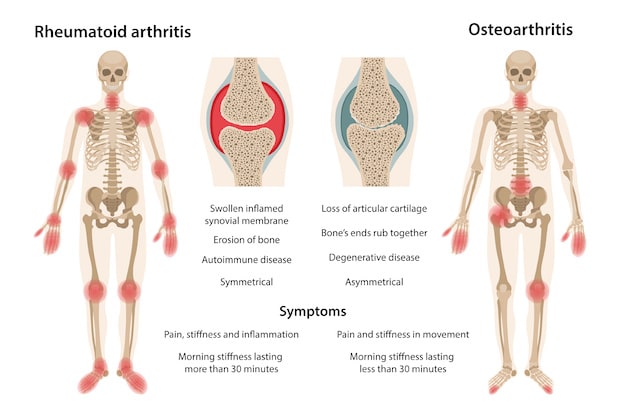Table of Contents
I. The Effect of Arthritis on the Body
The Effect of Arthritis on the Body
Many people think that arthritis is a normal part of growing older, but that is not always the case. Wear and tear, or osteoarthritis (OA), may occur over time when the cartilage between joints deteriorates, causing the bones to grind against each other. This type of arthritis most often occurs in the knees and hips and leads to stiffness and pain in the joints. Rheumatoid arthritis (RA) affects the body in the same way, but for different reasons. This type is an autoimmune condition that doesn’t necessarily affect the joints because of overuse. RA occurs due to a combination of genetic and environmental factors and can occur at any age.
Bones are not meant to grind against each other, so if this occurs for long periods, you may experience permanent disability. In the case of OA, complications can include:
- A pinched nerve in the spine
- Thinning or tearing of tendons around the joint
- A hairline crack in the bone
- Fluid-filled lumps behind the knees (Baker’s cysts)
- Infected joint [1]
RA often comes with more intense complications because it is an autoimmune disorder. When you have an autoimmune disorder, you are at a much higher risk of developing another autoimmune condition. Because of this, RA may cause: Arthritis can be treated with several drugs, including Mobic (meloxicam), indomethacin (also available in indomethacin suppositories), Celebrex (celecoxib), and Medrol (methylprednisolone). Drugs can help combat symptoms, but there are several habits you can implement in your everyday life to improve your arthritis condition. Read on to learn more about living a successful life with arthritis. If you want to improve your arthritis condition, you must remain conscious of your body movements. It can be difficult to regulate your posture at all moments of the day, but it can significantly improve your arthritic joints. Poor posture can be bad for your health and increase your chance of developing back pain, headaches and worsening your arthritis condition. Poor posture can increase spinal pressure, amplifying the effects of osteoarthritis. It may take lots of practice, but good posture can significantly benefit your arthritis condition. One study found that an extra ten pounds of pressure are added to the lower back for every inch your head is thrust forward from the shoulder. The added weight of bad posture will only speed up your joint deterioration. [3] If you have arthritis, you may have to change some of your lifestyle habits. Being overweight can significantly worsen your condition and put more pressure on your skeletal frame. Extra weight can add dozens of pounds of pressure on your knees. This can increase the deterioration rate of your joint cartilage, worsening your arthritis symptoms. [4] Recent studies have found that smoking for 20 years or more significantly increases your risk of developing rheumatoid arthritis. Smoking negatively affects almost every function of the body and can reduce the effectiveness of certain RA drugs. It is important to kick your smoking habit to improve your arthritis treatment. [5] Many people spend their days working behind a desk. If you have arthritis, this sedentary activity may negatively impact your condition. It is essential to keep moving and not stay in one position for too long. This is especially important if you have a desk job. You can get up and stretch every 15 minutes to exercise your joints and muscles. Even on the weekends, this brief stretching process can be done if you are sitting at home or watching television. [6] You may want to alter the way you use your muscles if you have arthritis. When possible, you should use your strongest joints and muscles to open heavy doors and other manual activities. If you have hip or knee arthritis, you can climb the stairs by leading with your stronger leg to reduce your weaker leg's stress. [7] Just because you have arthritis doesn't mean that you cannot exercise. If your arthritis is advanced, you may have a decreased range of movement and fairly constant pain and stiffness. Luckily, exercise can improve these symptoms if it is done correctly. Those with arthritis may want to focus on activities that build muscles around the joints but don't pressure or damage the joint. Some arthritis-friendly activities include: It is essential to stretch before performing any activity to reduce the tearing or damage or joint tissue or cartilage. You will likely want to avoid: Negative attitudes and stress can worsen your arthritis condition. If you are feeling down because of your symptoms, it is important not to dwell on negativity. Those feelings will continue to escalate and perpetuate pain and increase your risk of disability. If you need help staying relaxed, there are several techniques you can implement to improve your mood. To relax, you may want to: If you are still having trouble staying relaxed, you may want to seek a mental health professional. You can try cognitive behavioral therapy (CBT), which combines talk therapy and behavioral modifications. With the help of a trained CBT specialist, you can break cycles of self-defeating thoughts and actions. You can also implement self-care routines that can help you relax as well as improve arthritic symptoms. Hot and cold therapies can help sore muscles and relieve pain. Applying ice packs for sore muscles and heating pads on your arthritic areas can relax your mind as well as the body. [6] The content in this article is intended for informational purposes only. This website does not provide medical advice. In all circumstances, you should always seek the advice of your physician and/or other qualified health professionals(s) for drug, medical condition, or treatment advice. The content provided on this website is not a substitute for professional medical advice, diagnosis, or treatment.
Keep That Back Straight
Tweak Your Lifestyle

Get Up & Move
Low-Impact Exercise

Keep a Level Head
